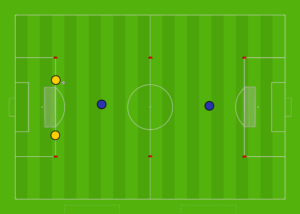“Sport is something that is very inspirational for young people.” – Pelé
I recently saw a post on social media where a coach was asking for help in getting 2 of his U11 players to pass the ball. Some of the 'advice' given was horrendous.
"Everytime they don't pass, put them on the bench, they'll soon get the message."
"Don't let them score at practice"
"Get rid of 'em"
"Leave them at home for the next game. They'll learn why"
If teachers behaved like this towards our kids we'd be calling for them to be sacked and excluded from teaching ever again. Yet when it comes to soccer apparently it perfectly justifiable behaviour from an adult. Judging by the above quote, these actions are as inspiring as working 35 hours a week to earn a £1.
Simply put, don't do any of this.
Players that want to beat everyone on their own must learn how, why, when and where to pass. They will not learn this by being dropped/cut/not being allowed to score. This, simply put, is lazy coaching. It is our job to help the players learn these things and we can do this by taking the following actions.
Find out why they Play that Way

A person's motivation can be based on intrinsic, extrinsic, physiological and achievement factors. Do you know what is the driving factor behind your players decision-making? Without asking them, their reasoning as to why could be any of the following
Parents have offered them money for each goal they score
They don't trust their team mates
They've never been taught to lift their head when on the ball
They're trying to emulate their favourite player
They get positive affirmation from parents when they beat a player
They like the challenge of trying to beat players
They're trying to improve their ability to beat multiple opponents
Any other reason...
Without understanding why players' behave in a certain way, we cannot help show them alternatives that will benefit them. For example, if the player is being offered a goal bonus by their parents, sitting them on the bench isn't going to change them wanting to score as many as possible. If they don't trust their team mates, cutting them from the team isn't going to help build that trust. Players not lifting their heads? They won't learn how to unless we design practices that teach them how, why, when and where.
It's 2019. It's okay for people to admit their faults and talk about their feelings. As coaches, it is vital we open those lines of dialogue and give ourselves an opportunity to understand our players better.
Explain WHY it Helps Them

Ever meet that young kid who can't stop asking "why?" Most of us have. At the time it can seem annoying, but that's not the reasoning for the child in question. They are simply looking to get to the truth and it happens with most children.
We are born inquisitive. We want to know how things are done and why we should do them. This goes for working with foundation age players also. Asking a player to pass the ball provides no real substance and gives no reasoning for why. Explaining that if they do pass when they have 3 players in front of them it will give the team a better chance to score, provides a solid reason that they can understand. In a similar manner, passing will allow them to move into space to get the ball back and give THEM a better chance to score, thus supporting their motivation if it is goal scoring.
Players will follow your lead if they understand why. It's your job to make sure they know.
Use Demo's to ask them WHY it works

Explaining the reasons why we do something is great, but most people don't want to be told what to do. This isn't just specific to children. Think about the last time someone gave you advice that you didn't ask for. What was your response? I'm guessing you switched off, ignored what was said and did things how you saw fit.
Asking questions has been shown to create a more engaged audience. People enjoy figuring out answers. My day job involves me working with kids who have been expelled from mainstream school. Despite their thoughts on education and being in school, they still engage when they are in charge of finding out the information required to complete their work or when they are contributing most of the discussion.
Stop the practice. Step in and ask the players in question what is in front of them and what the best solution. Ask them how they can make it better next time (type of pass, space to attack, lifting their head, using the open man etc). They may even give you an answer you haven't seen, thus increasing your own knowledge of the situation.
Start Small

If we want to show players the benefits of passing the ball, there is little point in starting with a practice that has 15/16 players on the pitch. There is far too much going on and they will be concerned that if they pass, they won't see the ball again. At Foundation Age Coaching, the first activity involving passing that we introduce players to is a basic 2 v 1 activity. This gives players a simple choice - pass or dribble. If the dribble is being blocked, use your team mate. If the pass is being blocked, carry on going forward.
While it seems simple, it is effective. Players have got time to lift their head, they have a very simple decision to make without the fear of too much pressure from opponents, they know that if they don't have the ball there is a chance they will get the ball back and they have the chance to score.
Are they Looking Up?

I have seen a lot of coaches get frustrated when a player has decided to go alone rather than pass. I remember watching one game in particular, where a player lost the ball from dribbling and his coach shouted "MAKE SURE YOU PASS TO AARON!!!"
Apart from that being an extremely flaky coaching point, it didn't help solve the issue of the boy in question having his head down. He wasn't confident enough in a 1v1 situation to lift his head and see what was around him. Whether this was due to ability, poor soccer education or the pressure of the game is hard to say. As coaches, the only thing they could control going forward is practices that would allow that player and his team mates to work on that skill.
I am a big fan of 1v1 practices. They provide a lot of benefits for players and can be structured in a way that encourage possession, creativity and movement. Our Keep the Ball activity does exactly that, leaving no other choice for players but to keep their head up and see not only the pressure behind them but also the options in front of them.

